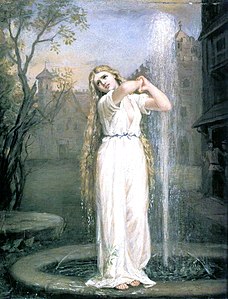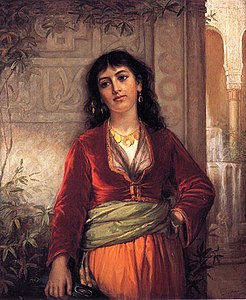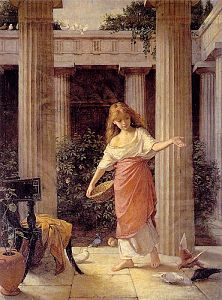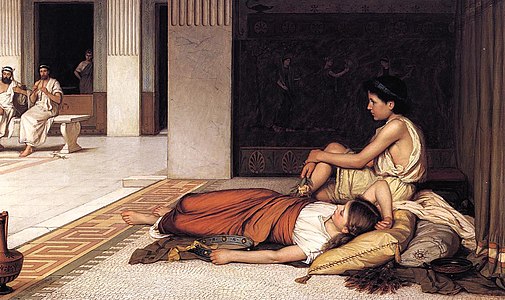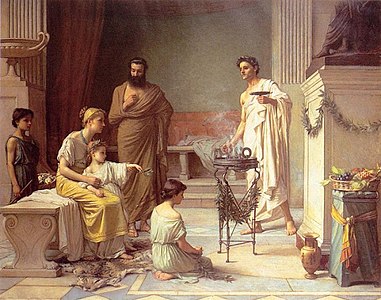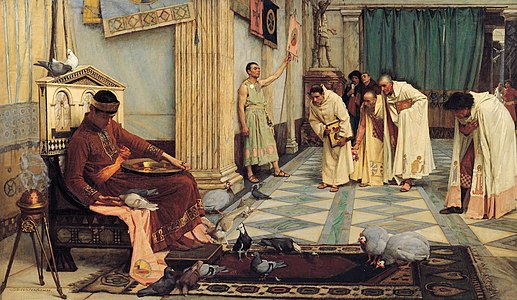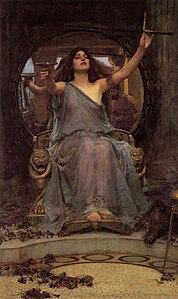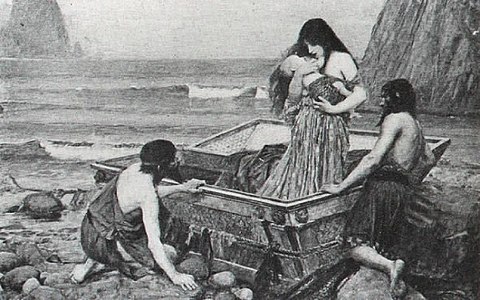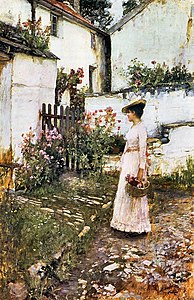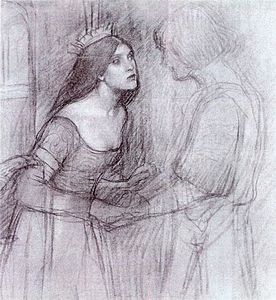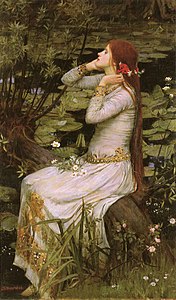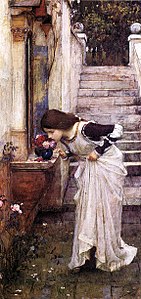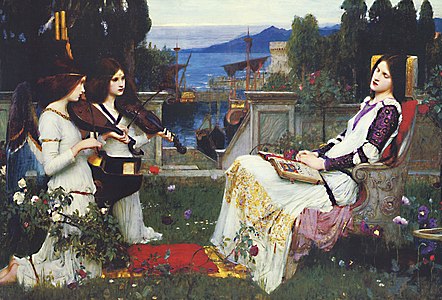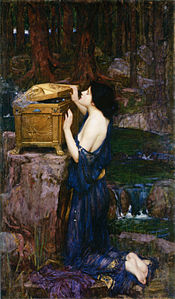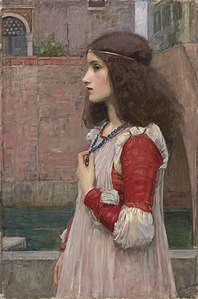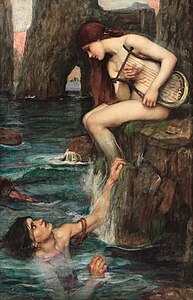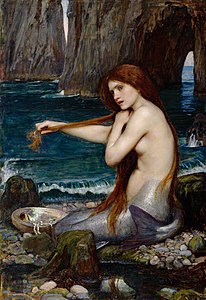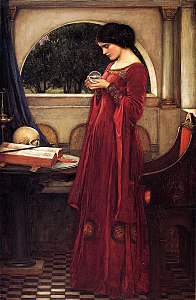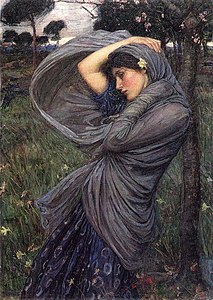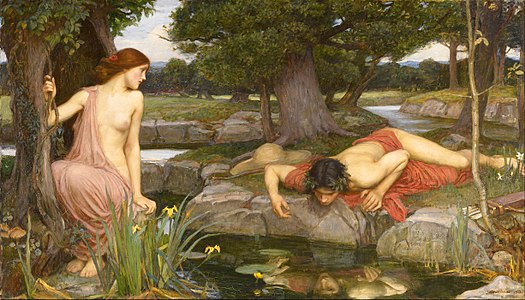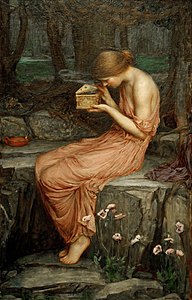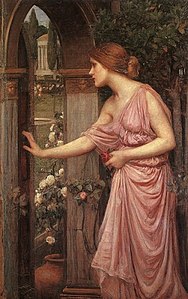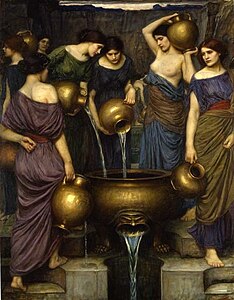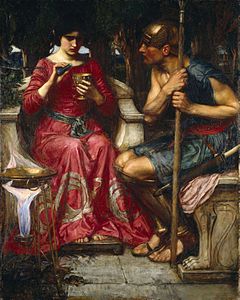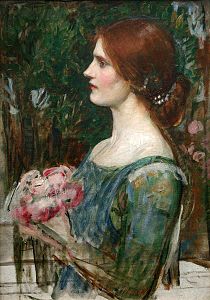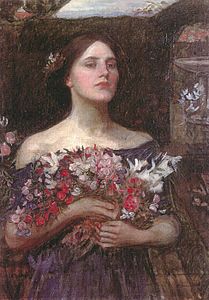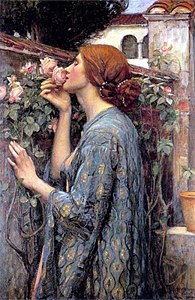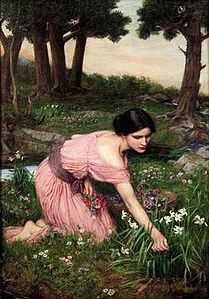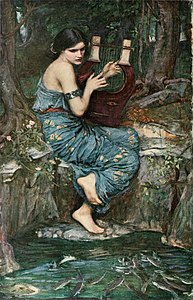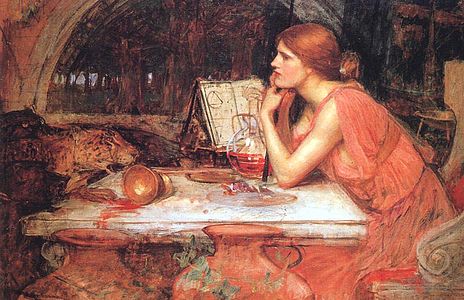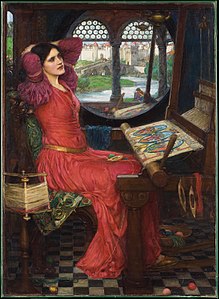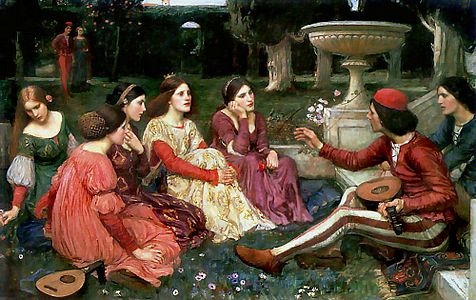John William Waterhouse
John William Waterhouse | |
|---|---|
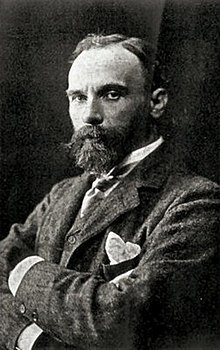 Waterhouse,c. 1886 | |
| Born | |
| Baptised | 6 April 1849[1] |
| Died | 10 February 1917(aged 68) |
| Nationality | British |
| Works | Hylas and the Nymphs The Lady of Shalott The Magic Circle Ophelia A Mermaid |
| Movement | Pre-Raphaelite |
| Spouse | Esther Kenworthy Waterhouse |
John William WaterhouseRA(baptised 6 April 1849 – 10 February 1917) was anEnglish painterknown for working first in theAcademic styleand for then embracing thePre-Raphaelite Brotherhood's style and subject matter. His paintings are known for their depictions of women from both ancientGreek mythologyandArthurian legend.A high proportion depict a single young and beautiful woman in a historical costume and setting, though there are some ventures intoOrientalist paintingandgenre painting,still mostly featuring women.
Born inRometo English parents who were both painters, Waterhouse later moved to London, where he enrolled in theRoyal Academy of ArtSchools. He soon began exhibiting at their annual summer exhibitions, focusing on the creation of largecanvasworks depicting scenes from the daily life and mythology ofancient Greece.Many of his paintings are based on authors such asHomer,Ovid,[2]Shakespeare,Tennyson,orKeats.
Waterhouse's work is displayed in many major art museums and galleries, and theRoyal Academy of Artorganised a major retrospective of his work in 2009.
Biography[edit]
Early life[edit]
Waterhouse was born in the city of Rome to the English painters William and Isabella Waterhouse in 1849, in the same year that the members of the Pre-Raphaelite Brotherhood, includingDante Gabriel Rossetti,John Everett MillaisandWilliam Holman Hunt,were first causing a stir in the London art scene.[3]The exact date of his birth is unknown, though he wasbaptisedon 6 April, and the later scholar of Waterhouse's work,Peter Trippi,believed that he was born between 1 and 23 January.[1]His early life in Italy has been cited as one of the reasons many of his later paintings were set inancient Romeor based upon scenes taken fromRoman mythology.
In 1854, the Waterhouses returned to England and moved to a newly built house inSouth Kensington,London, which was near to the newly foundedVictoria and Albert Museum.Waterhouse, or 'Nino' as he was nicknamed, coming from an artistic family, was encouraged to become involved in drawing, and often sketched artworks that he found in theBritish Museumand theNational Gallery.[4]In 1871, he entered the Royal Academy of Art school, initially to study sculpture, before moving on to painting.
Early career[edit]
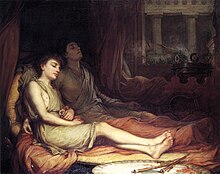
Waterhouse's early works were not Pre-Raphaelite in nature, but were of classical themes in the spirit ofAlma-TademaandFrederic Leighton.These early works were exhibited at theDudley Gallery,and theSociety of British Artists,and in 1874 his paintingSleep and his Half-brother Deathwas exhibited at theRoyal Academy summer exhibition.[5]The painting was a success and Waterhouse would exhibit at the annual exhibition every year until 1916, with the exception of 1890 and 1915. He then went from strength to strength in the London art scene, his 1876 pieceAfter the Dancebeing given the prime position in that year's summer exhibition. Perhaps due to his success, his paintings typically became larger.[5]
Later career[edit]
In 1883, Waterhouse marriedEsther Kenworthy,the daughter of an art schoolmaster fromEalingwho had exhibited her own flower-paintings at the Royal Academy and elsewhere. In 1895 Waterhouse was elected to the status of full Academician. He taught at theSt. John's Wood Art School,joined the St John's Wood Arts Club, and served on the Royal Academy Council.
One of Waterhouse's best known subjects isThe Lady of Shalott,a study ofElaine of Astolatas depicted in the1832 poembyAlfred, Lord Tennyson,who dies of a mysterious curse after looking directly at the beautifulLancelot.He actually painted three different versions of this character, in 1888, 1894, and 1916. Another of Waterhouse's favorite subjects wasOphelia;the most familiar of his paintings of Ophelia depicts her just before her death, putting flowers in her hair as she sits on a tree branch leaning over a lake. LikeThe Lady of Shalottand other Waterhouse paintings, it deals with a woman dying in or near water. He may also have been inspired by paintings of Ophelia byDante Gabriel RossettiandJohn Everett Millais.

He submitted his 1888Opheliapainting in order to receive his diploma from the Royal Academy. (He had originally wanted to submit a painting titledA Mermaid,but it was not completed in time.) After this, the painting was lost until the 20th century. It is now displayed in the collection ofLord Lloyd-Webber.Waterhouse would paint Ophelia again in 1894 and 1909 or 1910, and he planned another painting in the series, calledOphelia in the Churchyard.
Waterhouse could not finish the series of Ophelia paintings because he was gravely ill withcancerby 1915. He died two years later, and his grave can be found atKensal Green Cemeteryin London.[6]
Gallery[edit]
In total, he produced 118 paintings. SeeList of paintings by John William Waterhousefor an almost complete list.
1870s[edit]
-
Undine
1872 -
Gone, But Not Forgotten
1873 -
La Fileuse
1874 -
In the Peristyle
1874 -
Miranda
1875 -
After the Dance
1876 -
A Sick Child brought into the Temple of Aesculapius
1877 -
The Remorse of the Emperor Nero after the Murder of his Mother
1878
1880s[edit]
-
Dolce far Niente
1880 -
Diogenes
1882 -
Saint Eulalia
1885 -
The Magic Circle
1886 -
Mariamne Leaving the Judgement Seat of Herod
1887 -
Cleopatra
1888 -
Ophelia
1889
1890s[edit]
-
A Roman Offering
1890 -
Danaë
1892 -
Circe Invidiosa
1892 -
Gathering Summer Flowers in a Devonshire Garden
1892-1893 -
A Female Study
1894 -
Ophelia
1894 -
The Shrine
1895 -
Saint Cecilia
1895 -
Pandora
1896 -
Juliet
1898 -
Ariadne
1898
1900s[edit]
-
The Siren
1900 -
Destiny
1900 -
The Lady Clare
1900 -
Study for Nymphs Finding the Head of Orpheus
1900 -
Nymphs Finding the Head of Orpheus
1900 -
The Mermaid
1901 -
The Crystal Ball
1902 -
The Missal
1902 -
Windflowers
1902 -
Boreas
1903 -
Psyche Opening the Golden Box
1903 -
Psyche Opening the Door into Cupid's Garden
1904 -
The Danaides,1906
-
Jason and Medea
1907 -
Isabella and the pot of basil
1907 -
The Bouquet
(a study)
1908 -
Gather Ye RosebudsorOphelia(a study)
c. 1908 -
The Soul of the RoseorMy Sweet Rose
1908 -
Lamia
(version 2)
1909 -
Thisbe
1909
1910s[edit]
-
Ophelia
1910 -
Spring Spreads One Green Lap of Flowers
1910 -
The Charmer
1911 -
The Sorceress
c. 1911-1915 -
Penelope and the Suitors
1912 -
The Annunciation
1914 -
Dante and Matilda(study) (formerly called "Dante and Beatrice")
c. 1914–17 -
Matilda(study) (formerly called "Beatrice")
c. 1915 -
A Tale from the Decameron
1916 -
Miranda – The Tempest
1916 -
Tristan and Isolde
1916
References[edit]
Notes[edit]
- ^abTrippi 2002,p. 9.
- ^Severino, Carlos Mesquita (2019).Representações das Metamorphoses de Ovídio em J. W. Waterhouse(masterThesis). Lisboa: Faculdade de Letras da Universidade de Lisboa.
- ^Trippi 2002,p. 4.
- ^Trippi 2002,p. 14.
- ^abTrippi, Peter; Prettejohn, Elizabeth; Upstone, Robert.J.M. Waterhouse: The Modern Pre-RaphaeliteGallery Guide. The Royal Academy of Art. 2009.
- ^J.W. Waterhouse and the Magic of Color
Bibliography[edit]
- Trippi, Peter(2002).J. W. Waterhouse.New York, New York:Phaidon Press.ISBN9780714842325.
Further reading[edit]
- Baldry, A. Lys(January 1895),J. W. Waterhouse and his Work,vol. 4, pp. 103–115
- Bénézit, E (2006). "Waterhouse, John William".Dictionary of Artists.Vol. 14. Paris: Gründ. pp. 668–669.
- Dorment, Richard (29 June 2009),"Waterhouse: The modern Pre-Raphaelite, at the Royal Academy – review",The Daily Telegraph
- Gunzburg, Darrelyn (2010). "John William Waterhouse, Beyond the Modern Pre-Raphaelite".The Art Book.17(2): 70–72.doi:10.1111/j.1467-8357.2010.01104.x.ISSN1368-6267.
- Hobson, Anthony (1980).The Art and Life of J.W. Waterhouse, RA, 1849-1917.Rizzoli.ISBN978-0-8478-0324-8.
- Moyle, Franny (13 June 2009),"Pre-Raphaelite art: the paintings that obsessed the Victorians [print version: Sex and death: The paintings that obsessed the Victorians]",The Daily Telegraph(Review),pp. R2–R3.
- Simpson, Eileen (17 June 2009),"Pre-Raphaelites for a new generation: Letters, 17 June: Pre-Raphaelite revival",The Daily Telegraph.
- Cartwright, Rob (2021),TURNING THE LIGHT ON J.W. WATERHOUSE, RA – A BIOGRAPHY
External links[edit]
- John William Waterhouse.net
- John William Waterhouse (The Art and Life of JW Waterhouse)Archived14 February 2020 at theWayback Machine;
- John William Waterhouse (Comprehensive Painting Gallery)
- John William Waterhouse (1849–1917)
- John William Waterhouse Style and Technique
- Waterhouse at Tate Britain
- Echo and Narcissus(1903)
- Ten Dreams Galleries
- John William Waterhouse in the "History of Art"
- Profile on Royal Academy of Arts Collections
- 25 artworks by or after John William Waterhouseat theArt UKsite
- Portraits of John William Waterhouseat theNational Portrait Gallery, London
- Trippi, Peter. "Waterhouse, John William (1849–1917)".Oxford Dictionary of National Biography(online ed.). Oxford University Press.doi:10.1093/ref:odnb/38885.(Subscription orUK public library membershiprequired.)
- "Waterhouse, John William".Who's Who.A & C Black.(Subscription orUK public library membershiprequired.)
- John William WaterhouseatLibrary of Congress,with 2 library catalogue records
- Findagrave burial record
- 1849 births
- 1917 deaths
- 19th-century English painters
- 20th-century English painters
- Italian emigrants to the United Kingdom
- Artists' Rifles soldiers
- Burials at Kensal Green Cemetery
- English male painters
- Neo-Pompeian painters
- English Orientalist painters
- Paintings by John William Waterhouse
- Painters from London
- People of the Victorian era
- Pre-Raphaelite painters
- Royal Academicians
- Members of the Royal Institute of Painters in Water Colours
- 20th-century English male artists
- 19th-century English male artists

